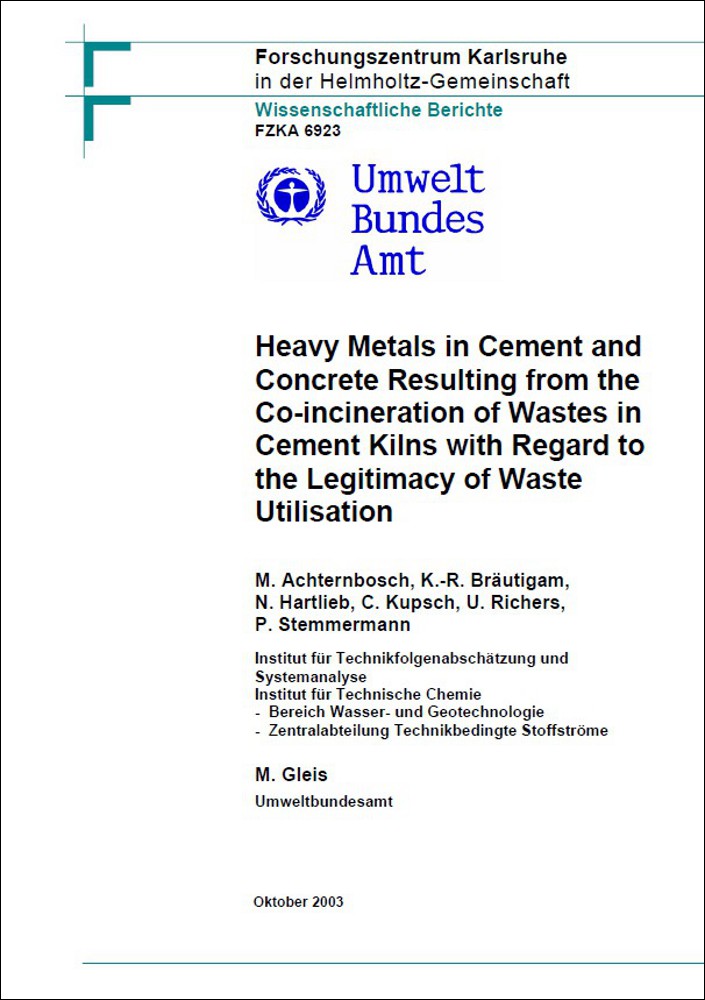Heavy metals in cement and concrete resulting from the co-incineration of wastes in cement kilns [10.12.2003]
The final report on "Heavy metals in cement and concrete resulting from the co-incineration of wastes in cement kilns with regard to the legitimacy of waste utilisation" is now published and online available.
The use of waste as a low-cost alternative fuel and raw material for the manufacturing process of cement is of increasing importance for the cement industry. However, when using waste in cement manufacture, it must be guaranteed that this use is proper and not harmful in the sense of the German Waste Management and Recycling Act (Kreislaufwirtschafts- und Abfallgesetz). Waste used as secondary fuel or as a substitute of inorganic raw material may contain varying trace element concentrations compared to conventional raw materials and regular fuels. The use of wastes inevitably leads to the question of where the trace elements of the wastes remain. The presently used procedures for cement manufacture cause the trace elements to be either transferred into the product cement or emitted with the exhaust gas into the environment. So far, main topics of discussion regarding the effects of waste utilisation were emission values from the clinker manufacturing process. However, recently the debate has moved away from emission values and is shifting towards the potential environmental impacts of the product cement and of cement-based construction materials.
Aim of this study was to investigate the impact of the use of secondary fuels, secondary raw materials and blending agents on trace element concentrations in cement and concrete. Furthermore, the aim was to investigate under which conditions and to which extent the incorporated trace elements can be released into the environment. Additionally, it should be proofed, whether regulations, standards, directives, etc. for the production of cement and corresponding construction products contain specific requirements for pollutant loads.
The study was performed on behalf of the Umweltbundesamt. It was conducted from 1.11.2000 to 31.3.2003 by ITAS in cooperation with the ITC-WGT and the ITC-ZTS of Forschungszentrum Karlsruhe.
The study has shown that presently used secondary raw materials and fuels result in some cases in a slight increase in trace element concentrations in cement. However, a general assessment of the use of wastes in cement production and of its impact on trace element input can not be performed. Furthermore, future developments can hardly be estimated.
The release of trace elements from concrete elements is negligible small during the phase of use. An increased release of trace elements is possible under special assumptions after demolition. However, the present knowledge is not sufficient for a definite assessment.
Existing regulations concerning the production and use of cement do not presently contain defaults for allowed concentrations of pollutants. However, changes can be expected in future due to demands which are presently worked out for the EU.
Bibliographic details:
M. Achternbosch, K.-R. Bräutigam, M. Gleis, N. Hartlieb, C. Kupsch, U. Richers, P. Stemmermann
Heavy metals in cement and concrete resulting from the co-incineration of wastes in cement kilns with regard to the legitimacy of waste utilisation. Karlsruhe: Forschungszentrum 2003 (Wissenschaftliche Berichte, FZKA 6923), 187 pages
Further information regarding the report:
Volltext/pdf (1 917 kb) Abstract/htm Zusammenfassung/htm Contents/htm
Links:
- Short description of project results in „Technikfolgenabschätzung - Theorie und Praxis“ 3-4/2003, S. 86-90 here
- Short project characterization here
- Personal homepage of authors from ITAS: Achternbosch Bräutigam Hartlieb Kupsch


